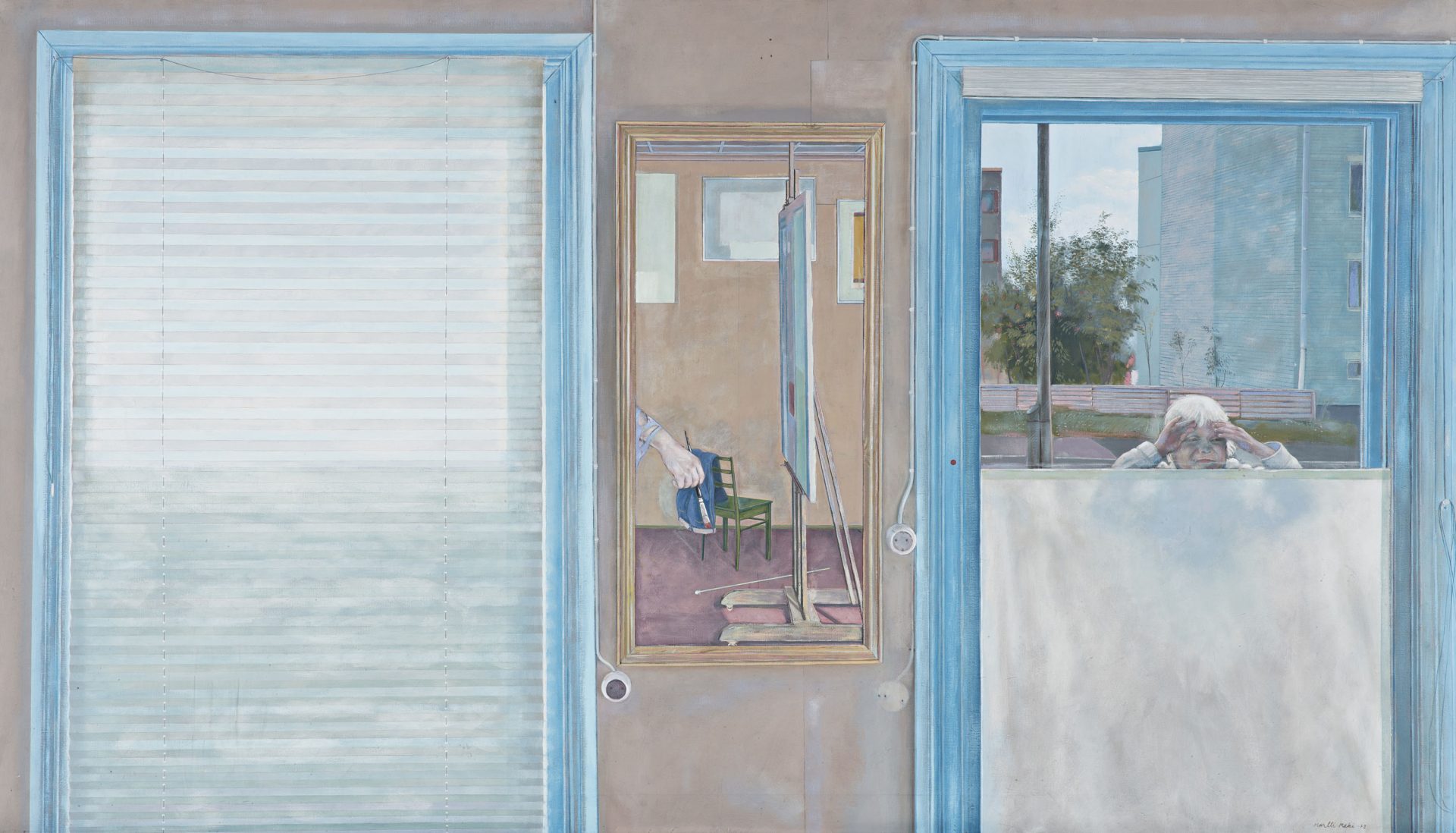Do you still remember your first school backpack, the rustle of rain pants or the smell of wet board sponge stuck to your palms? Did you walk, take the bus or perhaps ski to school? Did anything unexpected or memorable happen on your way to school?
The journey from home to school is not always straightforward. In School Road online exhibition, the collections of Oulu Art Museum brings to life moments when the journey to school drags on, the candy shop beckons, the fascinating world peeks through the window or a snowdrift invites you to play.
In autumn 2024, the Oulu Museum and Science Centre produced a virtual exhibition of the Orava School Museum, which also features works from the Oulu Art Museum’s collection related to school life. School Road online exhibition broadens the perspective on the paths between school and home. The exhibitions are part of the 150th anniversary of the Oulu Elementary School and the 50th anniversary of the Oulu Primary School.
In the exhibition you can read the memories of locals from their school journeys. A survey on school trips was carried out online and in a meeting of the Oulu Museum and Science Centre’s Senior Club.
The scrollable exhibition is designed to be used on a phone, tablet or computer. School Road online exhibition is part of regional art museum work. The exhibition is curated and produced by Hanna-Leena Ruottinen, regional museum researcher.
Hannu Kaakko: Backpack Company, 1989
Coloured woodcut on paper
112,8 x 90 cm
Oulu Art Museum Collection
Photo: Mika Friman
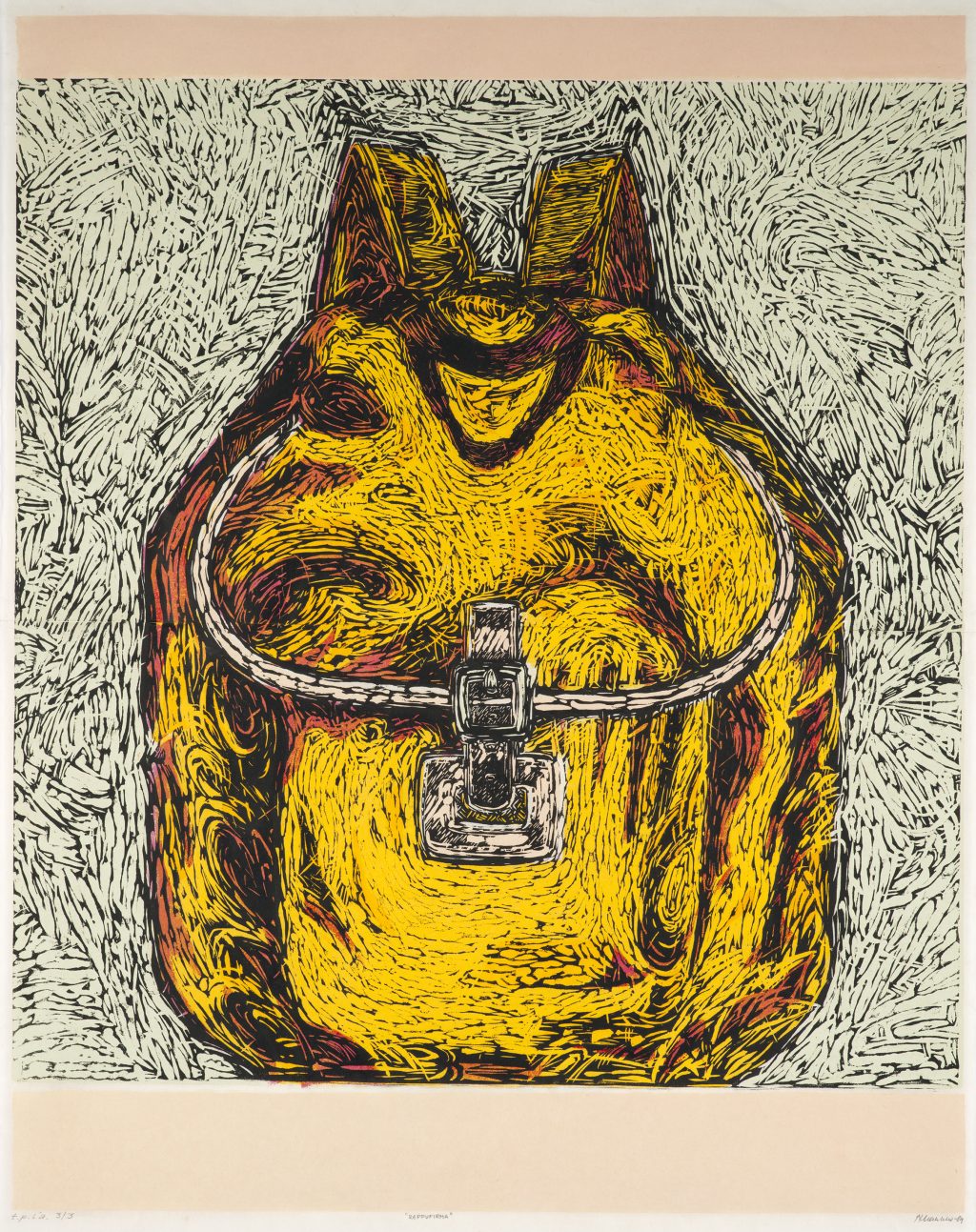
Backpacks are a standard accessory of schoolchildren and students. They carry schoolbooks, notebooks, pencil cases and even exercise clothing between home and school. Do you remember your first school backpack? Choosing and buying a backpack is a significant event for a child starting a school. The backpack represents thoughts of a coming semester and new opportunities, maybe even excursions and adventures. Many people get a new backpack for each school year, but classic and high-quality models will last through years.
Hannu Kaakko (1955–2005) was an artist and teacher from Oulu. His production includes paintings, prints, collages consisting of recycled materials and sculptures made with the Tiffany method.
Petri Hytönen: Bus Stop Dreams, 1999
Watercolour on paper
124 x 136 cm
Oulu Art Museum Collection
Photo: Ilkka Soini
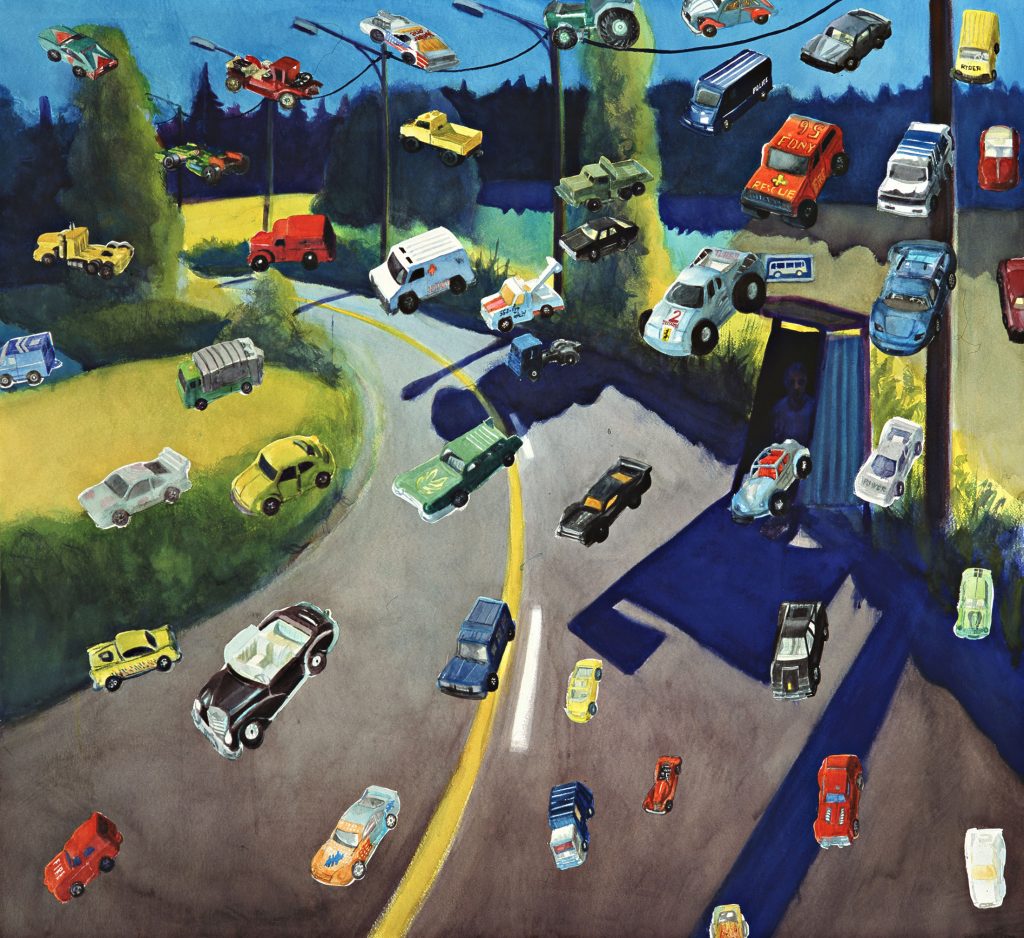
At first glance, colourful painting by Petri Hytönen only shows a huge number of different car models floating in the air, as if in a traffic jam on a major city motorway. After a little searching, a human form emerges from under the dark blue shadow of the bus stop canopy. According to the artist, the summery landscape in the painting is found in the countryside of the old rural municipality of his hometown Porvoo, where cars are a welcome addition and even dreamed of.
The artist has said that he has stepped on his own children’s toys on the floor on numerous occasions. Later, his own and his son’s cars were also piled up in a heap in the artist’s studio. Bus Stop Dreams, part of the Toys series, is the first work in which the toys ended up.
Petri Hytönen (born 1963) is a visual artist living in Porvoo. His major technique is watercolour.
Hannu Väisänen: Eight-year-old me on the school road, 1990
Watercolour and pencil on paper
50,5 x 36 cm
Oulu Art Museum Collection
Photo: Mika Friman
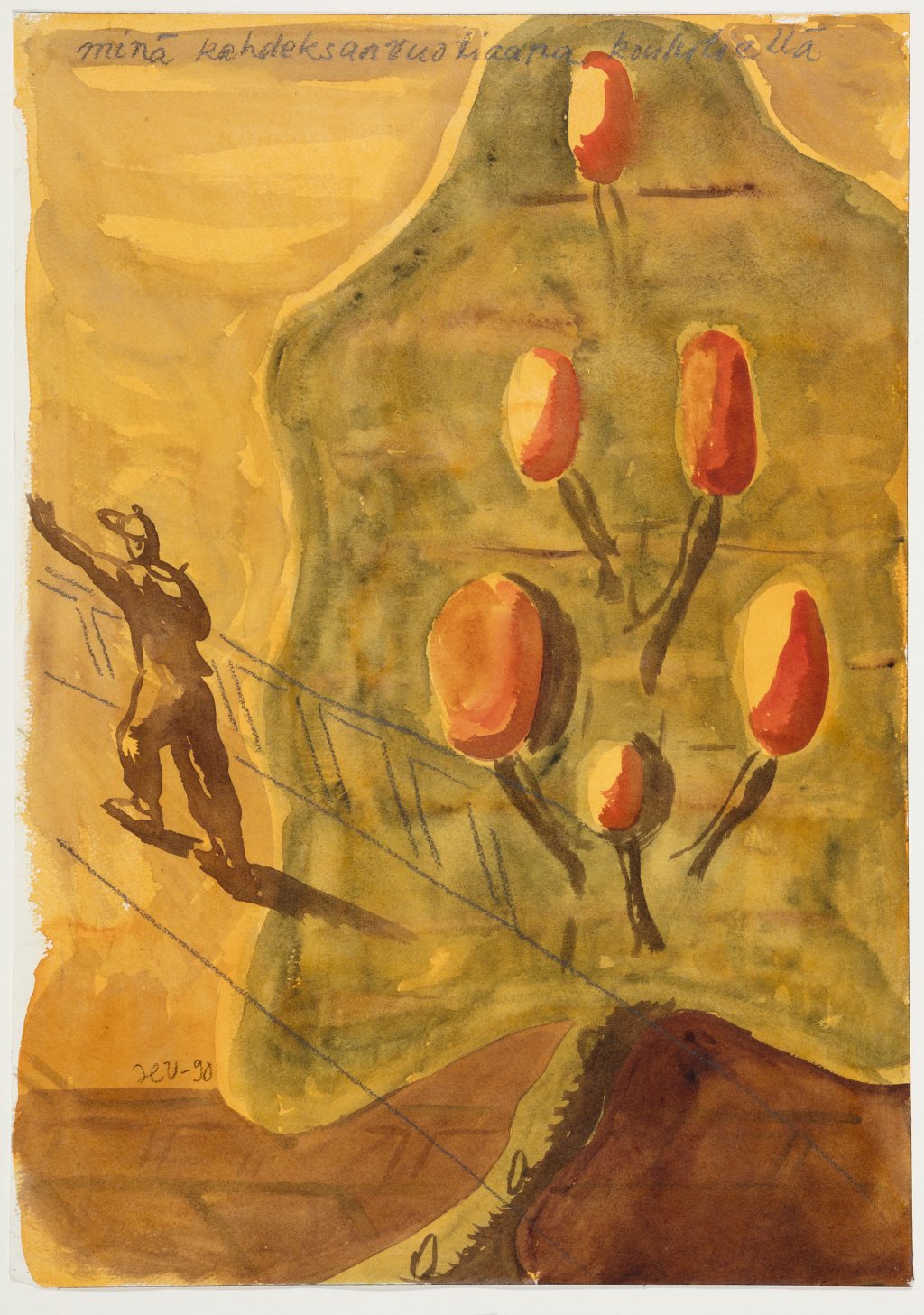
Hannu Väisänen spent his childhood and youth in the Intiö garrison area in Oulu. The artist has portrayed himself wearing a backpack on his way to the Oulunsuu Grade School. The artist has explained that he found confirmation in his selfhood and life mission on that school road.
Hannu Väisänen, who was born in Oulu in 1951 and later settled in France, is familiar to many with his meager and reduced expression of form and use of color. In addition to paintings, graphics and public sculptures, he is known as an author, textile designer, set designer and performer.
Nina Roos: 19:30, 2001
Oil on acrylic board
94,7 x 150 cm
Oulu Art Museum Collection
Photo: Anu Mykkänen
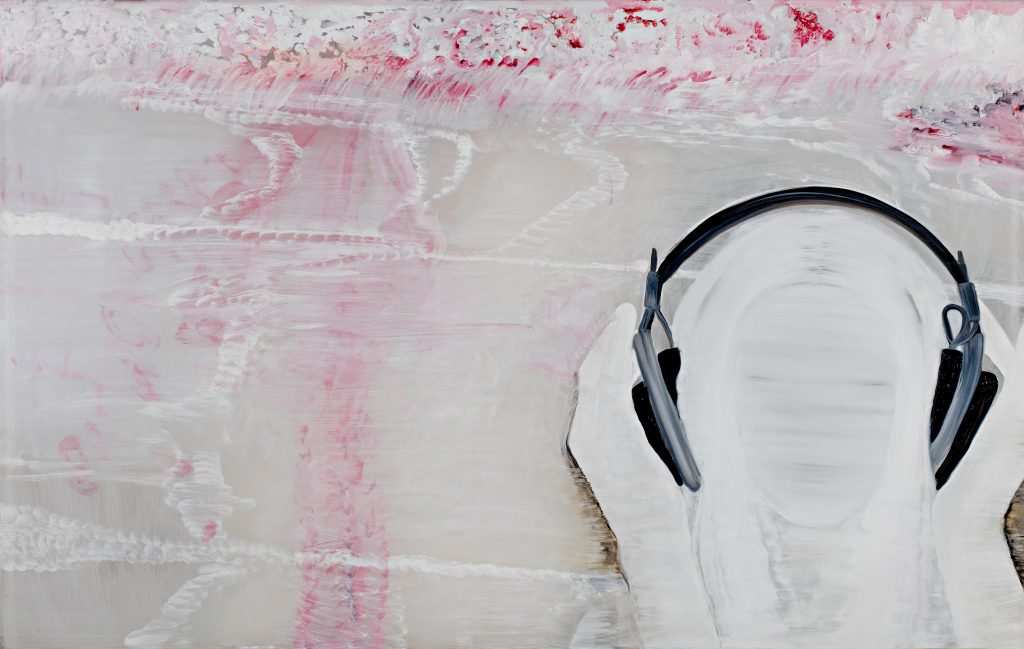
The title of the artwork “19:30” refers to time. The painting depicts a single precise moment, which in the blink of an eye changes into something else. The person in the painting wearing headphones is immersed in a closed soundscape. The artist’s idea was to depict the boundary between the inner and outer space. The details and identifiability of the environment and the person are blurred, which, combined with the minimalist palette, gives the work a timelessness and a hint of dream-like surrealism.
Nina Roos (b. 1956) usually works with series of paintings or drawings. Her expression range from abstract to representational.
Carl Wargh: View of The School, 1985
Watercolour on paper
55 x 75 cm
Oulu Art Museum Collection
Photo: Anu Mykkänen
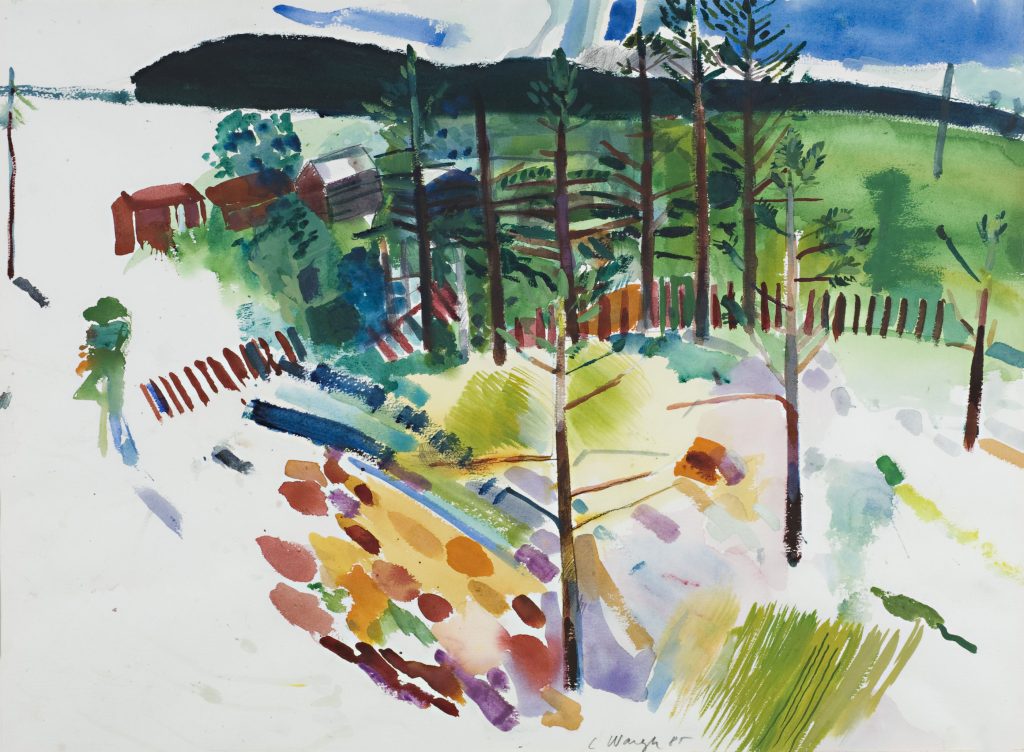
In Carl Wargh’s colourful watercolour the landscape is observed from a bird’s-eye view. The school in the painting peeks from behind tall pine trees in the otherwise open country scene with its fields and forests. As an artist, Wargh was more interested in capturing the transience of the landscape than its details. The school view lives its own colorful life led by flowing brush strokes.
Carl Wargh’s (1938–2018) primary technique was watercolour. Wargh’s works are held in dozens of museums and art collections in Finland and Sweden. The Vaasa-born artist worked as an art teacher and art critic his whole life. He was also an active member of visual arts organisations.
Paavo Tolonen: First Snow, 1978
Oil on canvas
120,5 x 210 cm
Oulu City Collection
Photo: Mika Friman
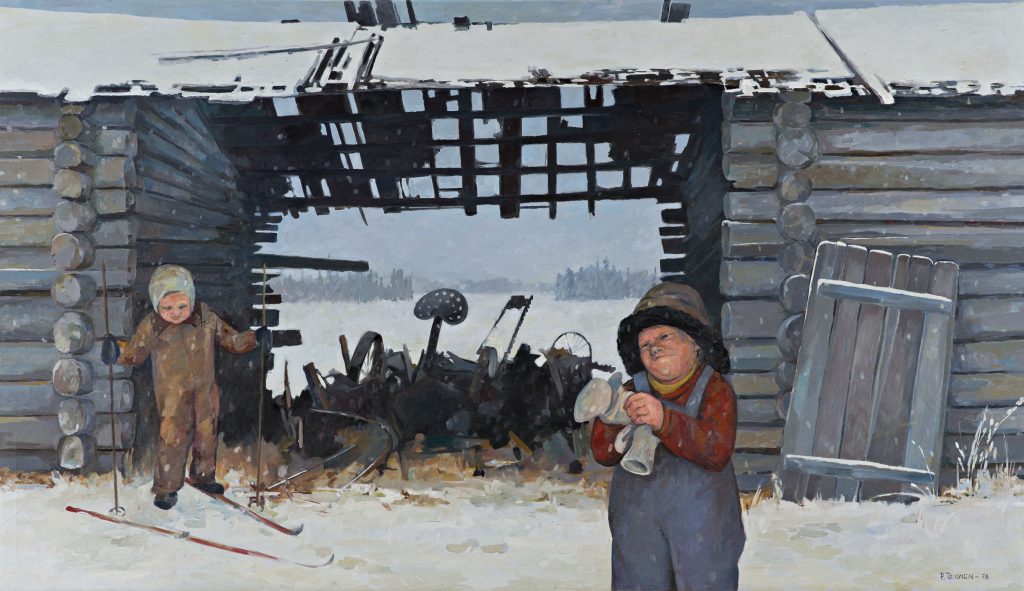
Two children are bustling around the run-down farmhouse. One of them is putting on a shovel while the other puts on skis. First snow has fallen, and it tempts the children to ski.
The artwork brings together Paavo Tolonen’s (1936–2009) most significant themes: nature, children, country life and realism. Portrayals of children were especially close to Paavo Tolonen’s heart.
Tolonen, who created his artistic production in Pudasjärvi, is known especially for his country realism in the 1970s which includes depictions of the rural transition and the effects of urbanization. The artist’s long career included a wide range of stylistic periods.
Noora Isoeskeli: The Wisdom of Trees, 2011
Pigment ink print
80,1 x 80,1 cm
Oulu City Collection
Photo: Mika Friman
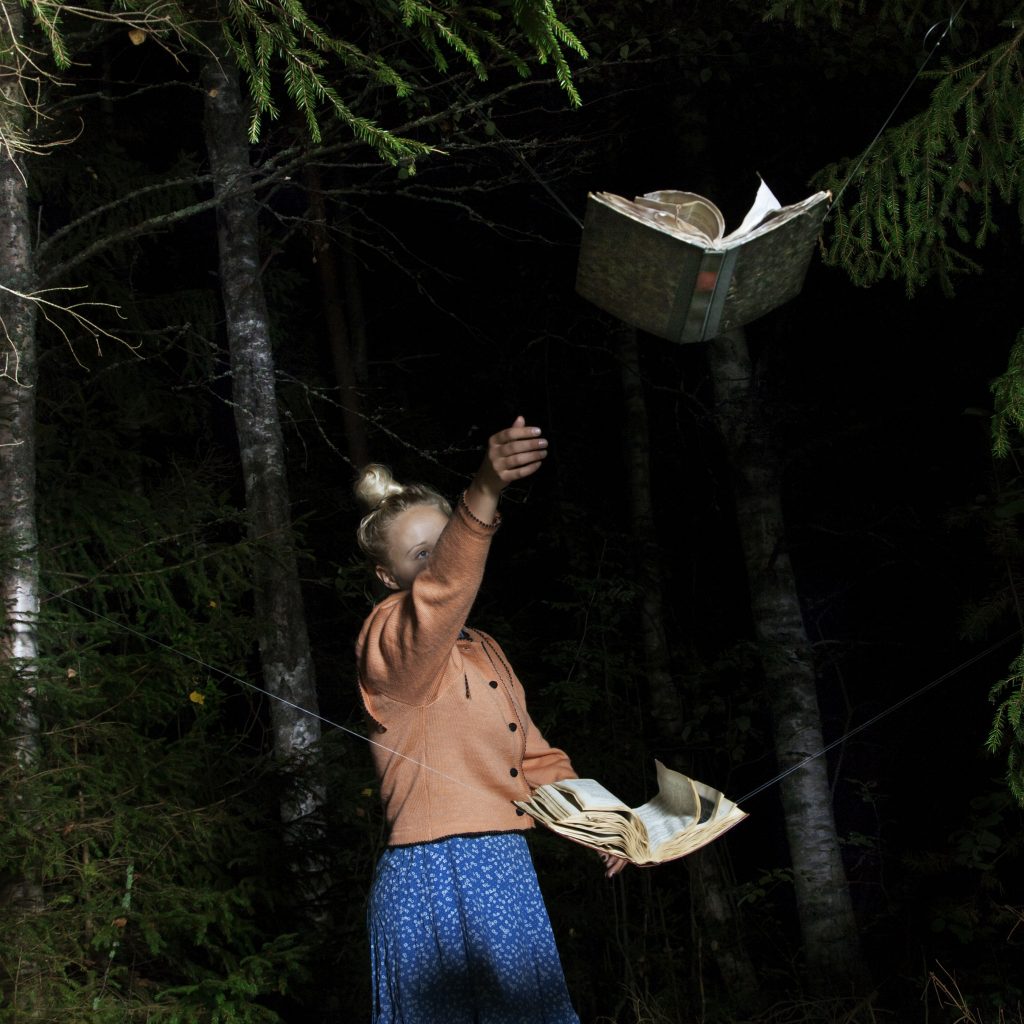
According to the artist, the artwork Wisdom of the Trees represents a relationship with nature and an attempt to understand what life is and what the surrounding world means. The young girl in the photograph is swinging two books on strings attached between trees. As explained by the artist, the girl is pursuing knowledge from the books even though she is surrounded by ancient trees. The underlying idea is that even though books are produced out of trees, our first attempt at understanding the world is experiential, sensuous. The artwork expresses being between two ways of knowing, reason and emotion. The artwork is part of the Temporary Happiness series.
Noora Isoeskeli (b. 1982) is a visual artist and photographer from Turku. Isoeskeli works primarily with staged photography. She is interested in questions about the power of the gaze in the world of seeing people.
Matti Kalkamo: Harsh Reality, 2005
Bronze, handmade woollen pullover
31 x 21,5 x 23,5 cm
Oulu Art Museum Collection
Photo: Mika Friman
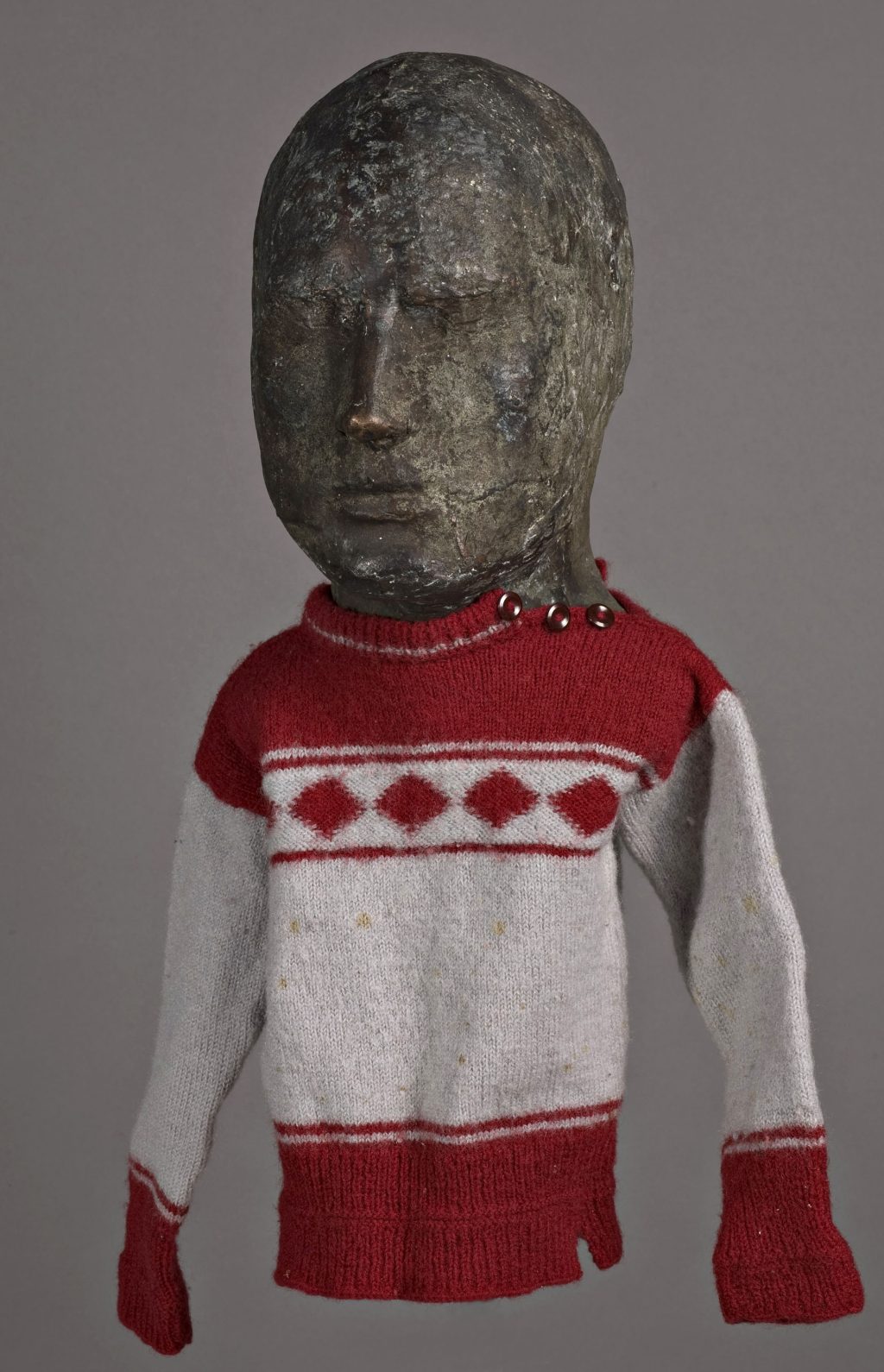
The character in Harsh Reality is sad and serious in his worn, partly broken sweater and seems to be wondering what went wrong. The tragicomic work is linked to the artist’s memories of elementary school battlegrounds with their king of the hill games and faces shoved in snow. Sometimes all you needed to create an enemy was a wrong kind of sweater. The ideas behind Kalkamo’s artworks usually derive from lived experiences and observations. Through the artwork, the artist wanted to take the place of the other as a bystander or onlooker. In Harsh reality Kalkamo has combined a donated and abandoned Jussi shirt with the bronze portrait.
Matti Kalkamo (born 1968) is a sculptor and installation artist from Tampere. Kalkamo’s artworks are often autobiographical.
Pirkko Lepistö: Tiny Skier, 1973
Oil on canvas
35,3 x 27,2 cm
Heinänen Art Foundation’s collection of naivist art
Photo: Anu Mykkänen
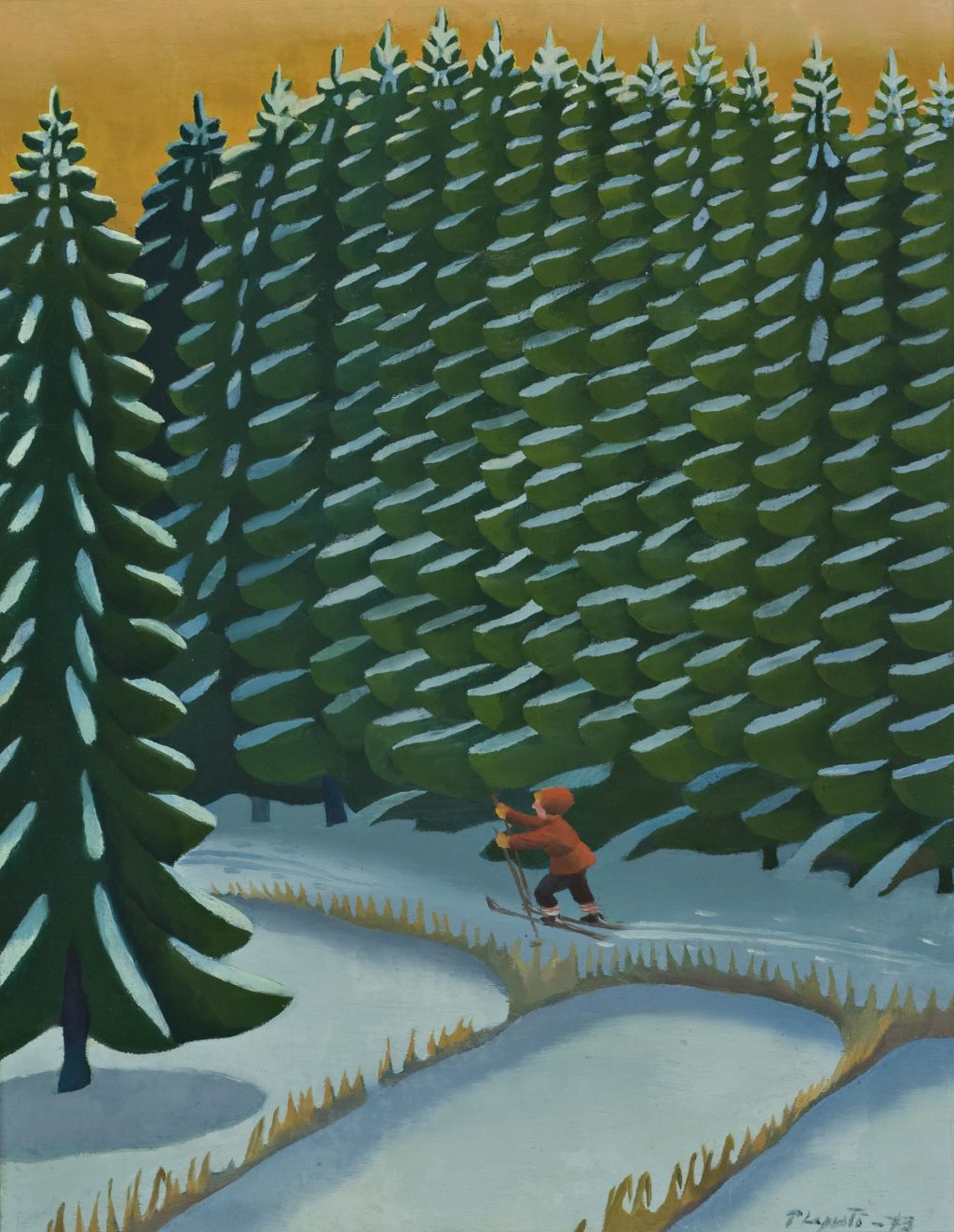
Pirkko Lepistö’s postcard-like painting presents a small wanderer skiing under tall, rhythmic trees. Snow has already covered the route defined by a previous trekker. Many small elementary school children used to ski to school in the winters. And it wasn’t always easy! There was often no light, and some pupils walked to school along different forest routes and paths. Sometimes pupils even used a rowboat.
Pirkko Lepistö (1922–2005) was one of Finland’s top naïve artists. Lepistö developed her own delicate, minimalist and compositionally disciplined style. Her paintings often describe a fairy-tale idyll and peace, which is typical for naïve art.
Reijo Hukkanen: The Ride Home, 1978
Oil and tempera on canvas
130 x 110,5 cm
Oulu Art Museum Collection
Photo: Mika Friman
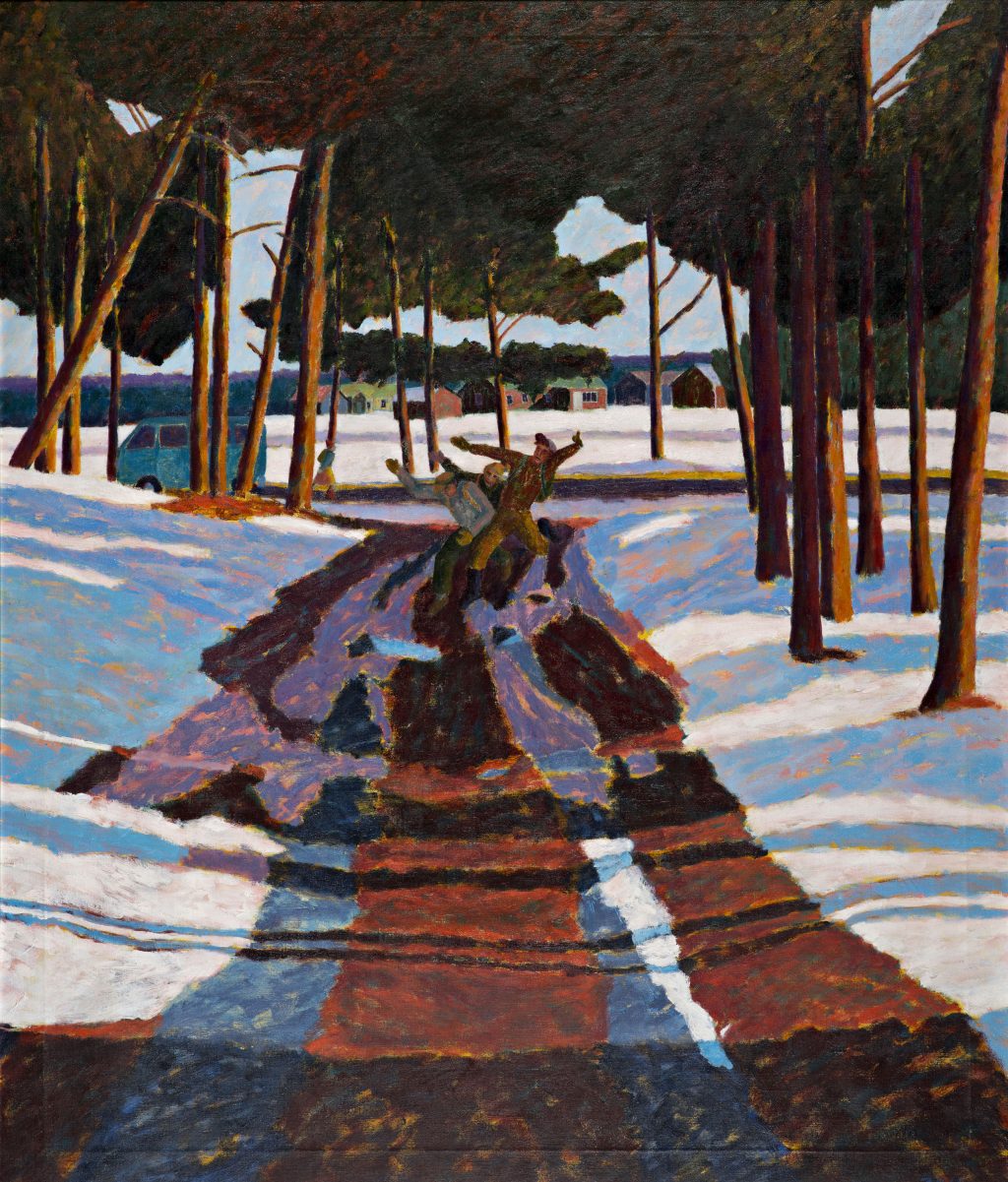
In Reijo Hukkanen’s painting, children are running with their backpacks on a forest path where they were dropped off by car. The spring sun stretches long shadows over the partially melted forest path. The beautiful landscape of Ojakylä in Hailuoto, the Ojakylä School and farmhouses can be seen in the background. Reijo Hukkanen has explained that the painting is based on a real situation he witnessed.
The Oulu-born artist Reijo Hukkanen (1946–2024) exchanged his brushes for hammers, metal shears and pop rivets in the early 1980s. In fact, many remember his impressive sculptures that utilized treasures from salvage yards and skips.
Jenni Yppärilä: Candy Shop (Oulainen), 2012
Mixed media, tree-dimensional painting on board
30 x 61 x 20 cm
Oulu Art Museum Collection
Photo: Mika Friman
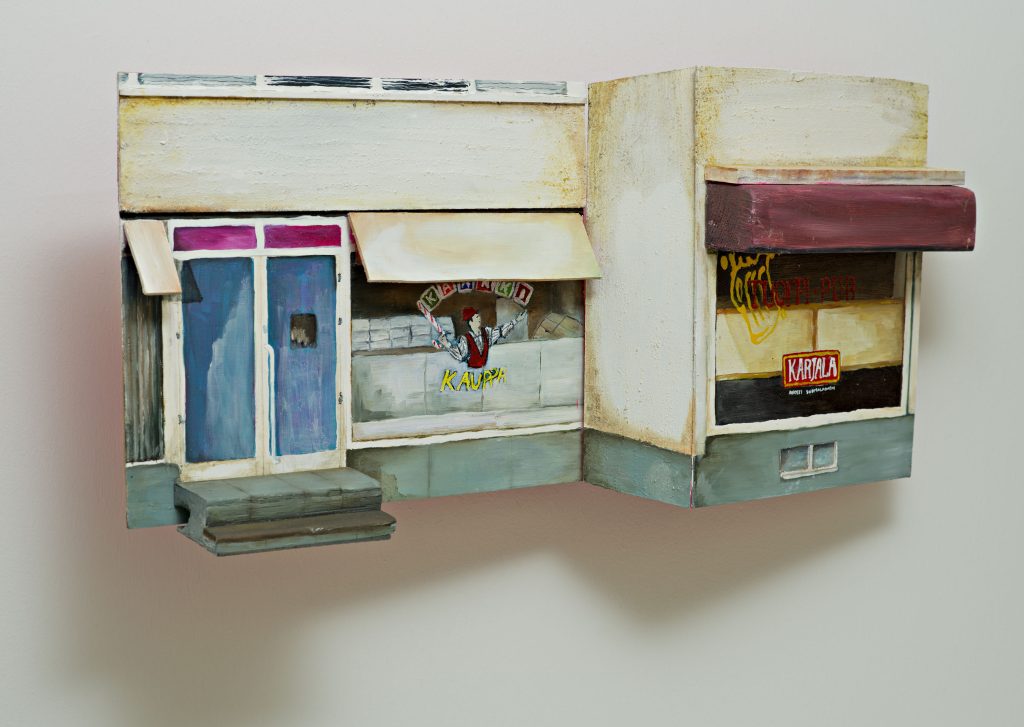
Jenni Ylppärilä’s three-dimensional painting Candy Shop (Oulainen) depicts a place that almost every person who grew up in Oulainen in the 70s and 80s can recognize. The Candy Shop was a place where a group of young people always spend time. It was a kind of base where social relations were maintained. The shop does not exist anymore. Architecturally, the building represents a style that could exist anywhere in Finland, and it is therefore easy to identify with the work. Ylppärilä’s paintings from the series of Was Here – meeting places are found all over Oulainen, Ikaalinen, Mänttä, Tampere, Pori and Pirkkala. The artist’s starting point was to look for public places where people of different ages meet and exchange their thoughts and opinions.
Jenni Ylppärilä (born 1980) is interested in the sociological character of buildings – buildings represent lived history, modernity, and they can be examined as portraits of society and its residents.
Martti Mäki: Afternoon, 1978
Tempera on canvas
120 x 210,3 cm
Oulu City Collection
Photo: Mika Friman
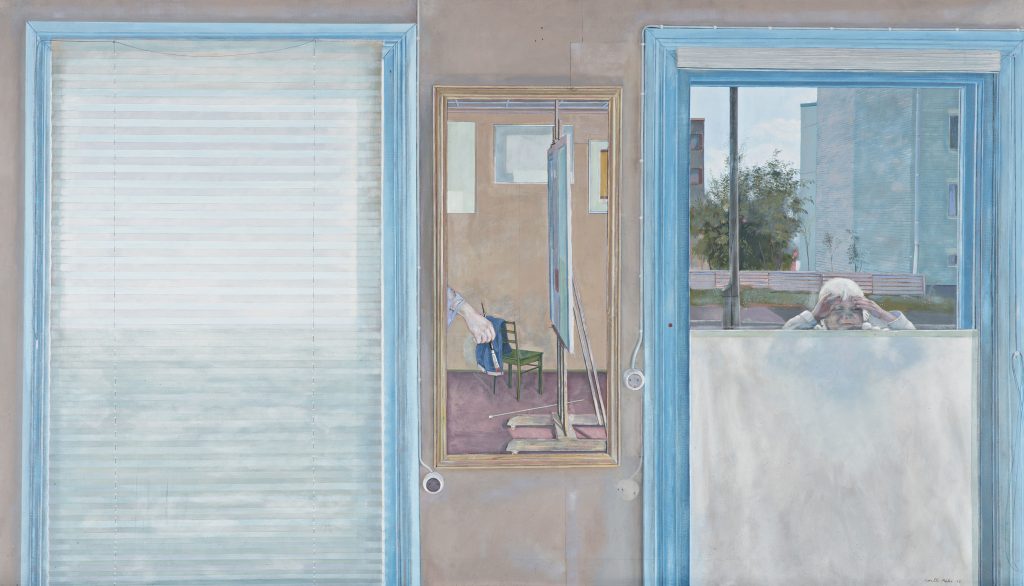
In 1974-82, the artist Martti Mäki had a studio in a wooden building in Tuira district of Oulu. The building previously housed a Spar grocery store. The space was large and had wide display windows to the street. According to the artist, he was often visited in the afternoons by a little boy who would peek through the window to see if the artist was at home. The boy stood on a bicycle seat to get a better view inside.
The tempera painting presents the studio from the inside. The mirror between two windows displays the inside of the room, the easel and the artist’s hand holding a brush. The other window opens a view of apartment buildings and a peeking small child.
Martti Mäki (born 1947) has produced multiple public mural paintings and commissioned portraits. Afternoon is a percentage art commission for the Rajakylä school.
Paavo Tolonen: Swings, 1983
Oil on canvas
80 x 100 cm
Oulu City Collection
Photo: Mika Friman
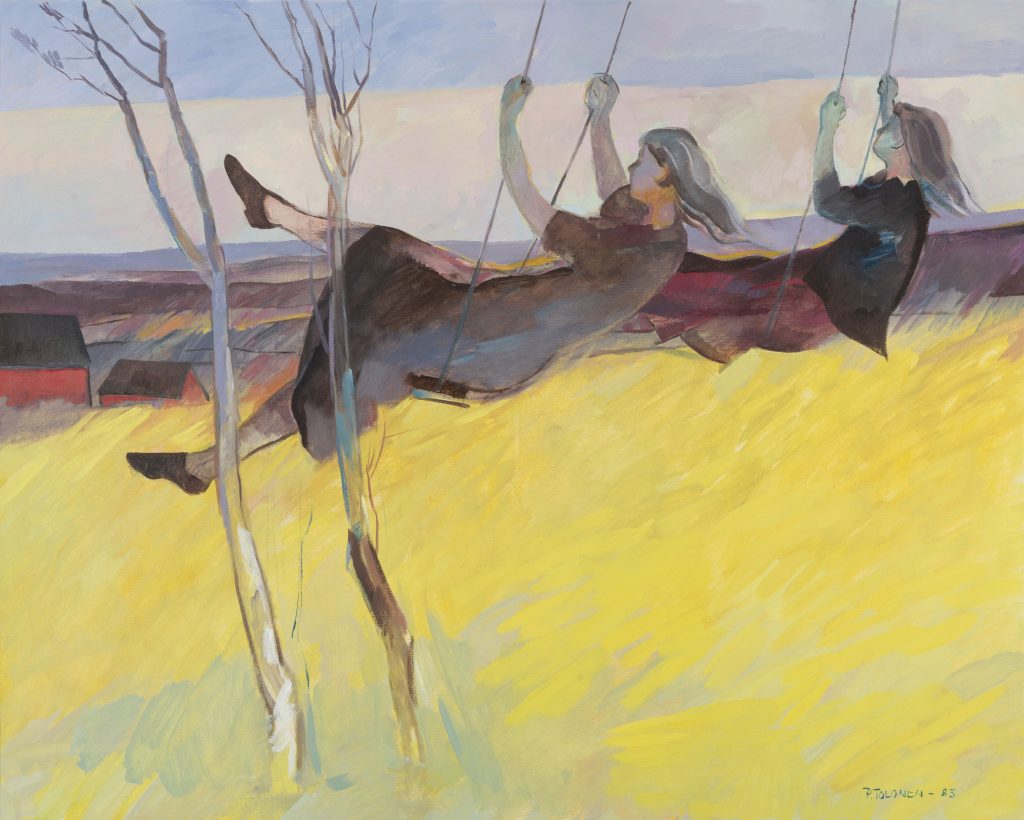
Swings by Paavo Tolonen reminds of late-summer grain fields and the feel of warmth and freedom. The moment when time is irrelevant.
Nature, children and country life are Paavo Tolonen’s (1936–2009) typical theme in his art. Tolonen was also a productive portrait painter.
Tuula Lehtinen: Chalkboard, 1995
Silk print and acrylic on canvas
120 x 200 cm
Oulu Art Museum Collection
Photo: Ilkka Soini
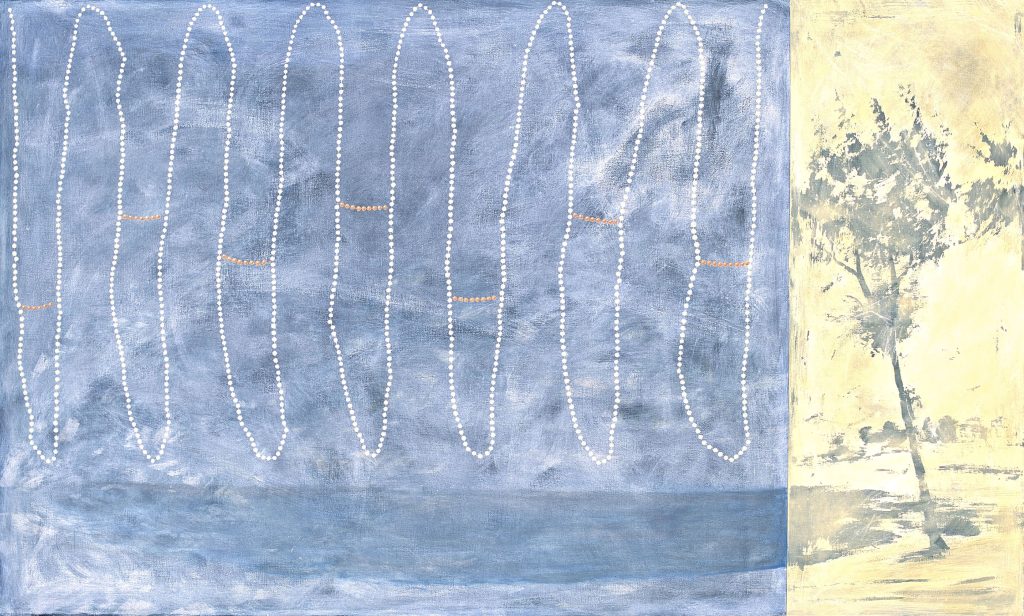
Tuula Lehtinen’s artwork consists of two parts in a way. It looks like an area reminiscent of a chalkboard is forcing its way into the middle of a sun-lit scenery. A white pearl necklace drawn upon the area may refer to dressing up, but it could also be an abacus used for mathematics.
Even though many chalkboards have been replaced with new innovations, the classic chalkboard is still a school memory for many. Do you still remember the smell of the chalkboard sponge?
Tuula Lehtinen’s (born 1956) production includes artworks made with different graphic methods, paintings, sculptures and mosaics. In recent years, she has become interested in the interaction between art and the surrounding space and architecture.
Teuvo-Pentti Pakkala: Boys and Fallen Tree, 1959
Litography on paper
31 x 45 cm
Oulu City Collection
Photo: Anu Mykkänen
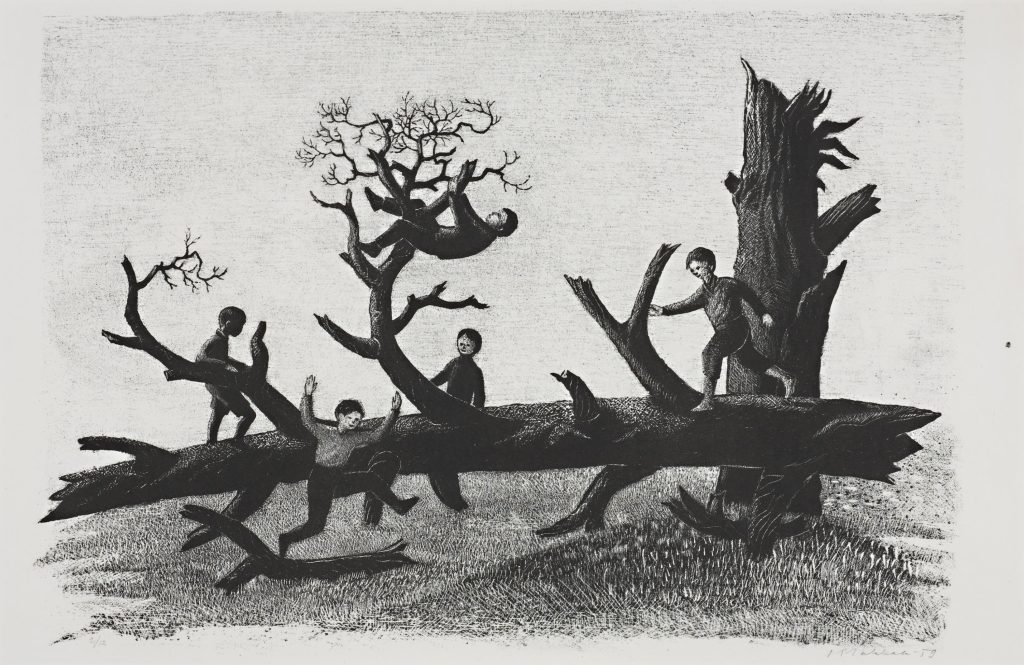
Teuvo-Pentti Pakkala’s graphic print is an exhilaration of play and speed! There is a scuffle by the fallen and branchy tree – some of the children are climbing on the branches and trunk, some running on the ground. Pakkala also made gouaches and watercolours on the same subject, but he later destroyed them.
Born in Oulu, Teuvo-Pentti Pakkala (1920–2010) belonged to a cultural family from Northern Ostrobothnia. As an artist, he was one of the leading artists of the post-war modernists in Finland. Pakkala did his lifework as a graphic artist in Helsinki and Hailuoto.
